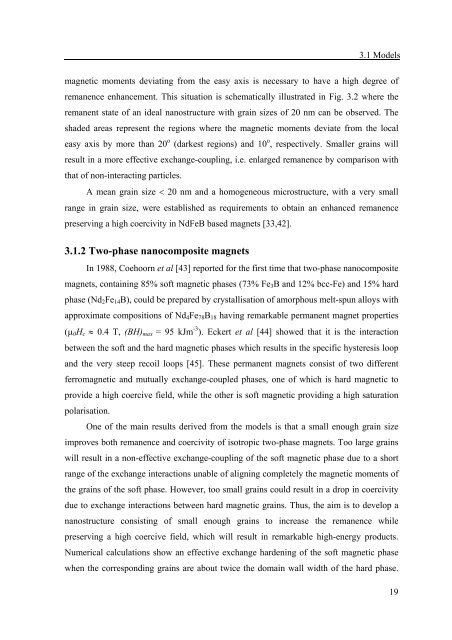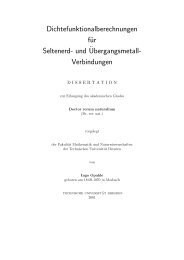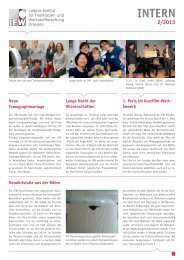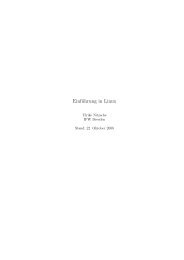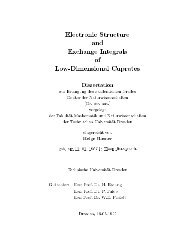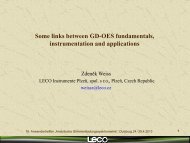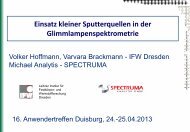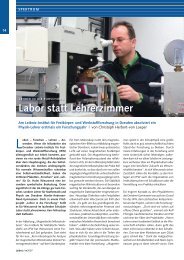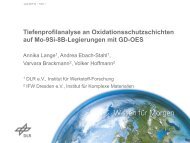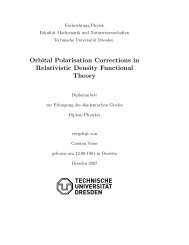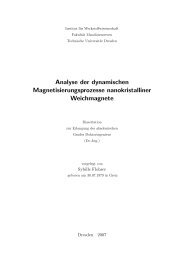ALBERTO BOLLERO REAL
ALBERTO BOLLERO REAL
ALBERTO BOLLERO REAL
Create successful ePaper yourself
Turn your PDF publications into a flip-book with our unique Google optimized e-Paper software.
3.1 Models<br />
magnetic moments deviating from the easy axis is necessary to have a high degree of<br />
remanence enhancement. This situation is schematically illustrated in Fig. 3.2 where the<br />
remanent state of an ideal nanostructure with grain sizes of 20 nm can be observed. The<br />
shaded areas represent the regions where the magnetic moments deviate from the local<br />
easy axis by more than 20 o (darkest regions) and 10 o , respectively. Smaller grains will<br />
result in a more effective exchange-coupling, i.e. enlarged remanence by comparison with<br />
that of non-interacting particles.<br />
A mean grain size < 20 nm and a homogeneous microstructure, with a very small<br />
range in grain size, were established as requirements to obtain an enhanced remanence<br />
preserving a high coercivity in NdFeB based magnets [33,42].<br />
3.1.2 Two-phase nanocomposite magnets<br />
In 1988, Coehoorn et al [43] reported for the first time that two-phase nanocomposite<br />
magnets, containing 85% soft magnetic phases (73% Fe 3 B and 12% bcc-Fe) and 15% hard<br />
phase (Nd 2 Fe 14 B), could be prepared by crystallisation of amorphous melt-spun alloys with<br />
approximate compositions of Nd 4 Fe 78 B 18 having remarkable permanent magnet properties<br />
(µ 0 H c ≈ 0.4 T, (BH) max = 95 kJm -3 ). Eckert et al [44] showed that it is the interaction<br />
between the soft and the hard magnetic phases which results in the specific hysteresis loop<br />
and the very steep recoil loops [45]. These permanent magnets consist of two different<br />
ferromagnetic and mutually exchange-coupled phases, one of which is hard magnetic to<br />
provide a high coercive field, while the other is soft magnetic providing a high saturation<br />
polarisation.<br />
One of the main results derived from the models is that a small enough grain size<br />
improves both remanence and coercivity of isotropic two-phase magnets. Too large grains<br />
will result in a non-effective exchange-coupling of the soft magnetic phase due to a short<br />
range of the exchange interactions unable of aligning completely the magnetic moments of<br />
the grains of the soft phase. However, too small grains could result in a drop in coercivity<br />
due to exchange interactions between hard magnetic grains. Thus, the aim is to develop a<br />
nanostructure consisting of small enough grains to increase the remanence while<br />
preserving a high coercive field, which will result in remarkable high-energy products.<br />
Numerical calculations show an effective exchange hardening of the soft magnetic phase<br />
when the corresponding grains are about twice the domain wall width of the hard phase.<br />
19


